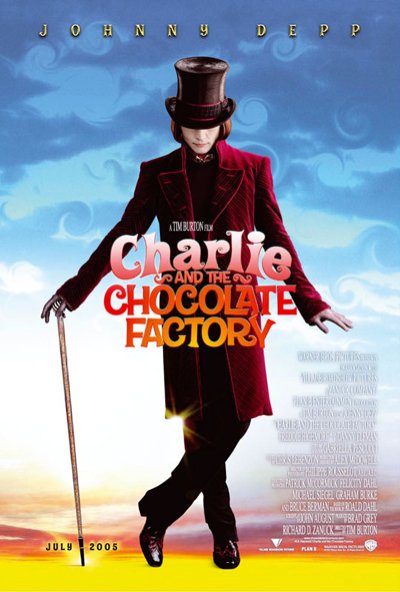(Note: the following was originally a reply to some of the questions raised in the comments discussing an upcoming Tim Burton/Johnny Depp version of Roald Dahl‘s Charlie and the Chocolate Factory. My response became long enough that I decided to give it a post of its own rather than “bl-hog” my own blog.)
I have to comment on this one : What is it with this movie [Willy Wonka and the Chocolate Factory] that people love it so much? It’s one of the creepiest films I’ve ever seen in my life.
Obviously I can’t speak for everyone, but as for myself, I think the creepiness is one of the major factors in just why I enjoy it.
I’ve always had a fascination for the dark, creepy, and bizarre — I count H.R. Giger as one of my favorite artists, and William S. Burroughs as one of my favorite authors, for instance — and Roald Dahl’s writing is right up my alley. It’s amusing really. So many people have this image of Dahl writing “children’s” books, born of hazy memories of the film version of Charlie and the Chocolate Factory, the stop-motion animation version of James and the Giant Peach, the Jim Henson version of The Witches, and so on. And to be sure, they are children’s books, however, they’re children’s books far closer in spirit to the original Grimm Brothers fairy tales than the pablum that passes for children’s literature today.
For some reason, our society seems to have decided that children need to be coddled, pandered to, and generally sheltered at any cost from the darker areas of life (while at the same time using the television as a babysitter without bothering to supervise what the children are watching…but that’s a rant for another time). Playgrounds are torn down and rebuilt to try to prevent the merest hint of the possibility of injury, classic fairy tales are “Disney-fied” to remove elements that are deemed inappropriate (no matter that they survived unaltered for tens and sometimes hundreds of years before that without our culture spontaneously imploding), toys are re-engineered from good solid long-lasting metal to flimsy plastic that doesn’t have any sharp corners but that breaks in months rather than years, and so on.
Children aren’t stupid, though. They know that life isn’t all sunshine and roses. From the first time they fall and skin a knee, or find their goldfish floating upside down in its bowl, or any number of any other day to day minor tragedies, children are no strangers to the darker side of life. They don’t approach these events in the same way that older people do, though — more often then not, after the initial trauma wears off, they’re curious and want to know the “why’s” behind what just happened — and this simple acceptance is so alien to our over-analytical “adult” minds that we fool ourselves into thinking that the children don’t understand. They do, though. They may not have the finer details and the subtleties down, they may not see it the same way adults do, but they understand.
The Grimm brothers understood this when they wrote their classic stories. Their tales were dark and disturbing, full of violence, abusive situations, scary moments, and everything that we seem to try to shield our children from in this overly “PC” day and age. But the stories had messages and morals to them that were passed onto the children that read them or heard them from their parents, and those messages and morals were probably all the more effective because they used the imaginations of the children, and the innate ability of the child’s mind to accept dragons, beasties, ghoulies, and things that go bump in the night just as easily as they accept rainbows, fairies, unicorns, and cute little gnomes living under toadstools.
Dahl also understands this in his children’s stories. His characters are flawed, rarely ever entirely good or entirely bad. They find themselves in fantastical situations that can be as wonderously exciting as they are chilling. His heroes learn the lessons that they should, but it’s never an easy course. No triumph is ever as sweet as that which carries a real risk of dismal failure, and if that simple truth is neglected, then the audience — whether an audience of one turning the pages of a book, or an theater audience watching an adventure unfurl on the screen — is cheated.
Some of the best “children’s” literature is that which doesn’t pander to the age group that the story is aimed at (and because of this, can often be enjoyed long past childhood and into adulthood). Along with Dahl and the Brothers Grimm, L. Frank Baum’s Oz books often took very dark turns, I’ve heard good things about Neil Gaiman’s Coraline (though I’ve yet to read it myself), J.K. Rowling’s Harry Potter books keep getting darker and darker (and better, and more popular) as the series progresses…I’m sure there are many, many other authors and examples that could be added to this list.
Yes, both the book and the movie of Charlie and the Chocolate factory are creepy — but that’s exactly as it should be, and that’s one of the reasons I think that the Burton/Depp collaboration could do an incredible job of re-creating the story (assuming, that is, that Burton doesn’t pull another Planet of the Apes out of his hat). I, for one, am hoping for the best.
“Super Charger Heaven (Adults Only)” by White Zombie from the album Supersexy Swingin’ Sounds (1996, 5:17).

